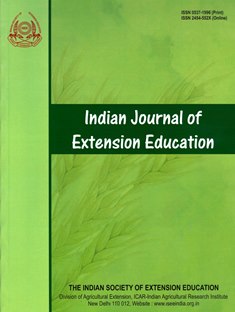Drivers of IPM Adoption among Hybrid Tomato Farmers in Karnataka: Insights through Mlogit Model
DOI:
https://doi.org/10.48165/IJEE.2025.61109Keywords:
Adoption, Hybrid tomato, Integrated pest management, Multinominal logistic regression, Sustainable agricultureAbstract
The investigation was undertaken during 2020 to study the adoption level of IPM practices and the factors influencing adoption among hybrid tomato growers in Karnataka as such studies are scanty in India despite 60 per cent market share of hybrid tomato. Primary data were collected using a structured interview schedule by personally interviewing 120 respondents. Findings revealed that cultural practices like crop rotation, exhibited higher adoption rates, while biological methods were relatively less adopted. Overall, IPM adoption remained limited, with only a small proportion of growers fully embracing these practices. Multinomial logistic regression (MLR) had Nagelkerke’s R-square or Pseudo R2 value of 0.609, indicating 60.90 per cent of total variations in the adoption level of IPM practices, explained by selected explanatory variables. Further, MLR identified factors significantly influencing the adoption of IPM were age (p=0.021), education (p=0.022), Extension contact (p=0.013), and cosmopoliteness (p=0.029) (odds ratio [OR], 6.707; 95% CI of OR 1.211 to 37.158) found significant at 5% level (p<0.05); while social participation (p=0.076) was found significant at 10 per cent level (p<0.10). Targeted interventions and training programmes are needed to promote sustainable practices, particularly among hybrid tomato growers, addressing barriers and enhancing the adoption of IPM practices.
Downloads
References
Bayaga, A. (2010). Multinomial Logistic Regression: Usage and Application in Risk Analysis. Journal of Applied Quantitative Methods, 5(2). https://jaqm.ro/issues/volume-5,issue-2/pdfs/ bayaga.pdf
Chattopadhyay, S. N., & Pareek, U. (1967). Prediction of multi practice adoption behavior from some psychological variables. Rural Sociology, 32(3), 324–333.
Depenbusch, L., Sequeros, T., Schreinemachers, P., Sharif, M., Mannamparambath, K., Uddin, N., & Hanson, P. (2023). Tomato pests and diseases in Bangladesh and India: farmers’ management and potential economic gains from insect resistant varieties and integrated pest management. International Journal of Pest Management,1-15. https://www.tandfonline.com/doi/full/10.1080/ 09670874.2023.2252760
FAO. (2020). FAOSTAT Database on Production. Rome, Italy, http:/ /www.fao.org/faostat/.
FAO. (2022). Pesticides Use, Pesticides Trade and Pesticides Indicators–Global, Regional and Country Trends, 1990–2020. FAOSTAT Analytical Briefs, no. 46. https://www.fao.org/3/ cc0918en/cc0918en.pdf
Kariathi, V., Kassim, N., & Kimanya, M. (2016). Pesticide exposure from fresh tomatoes and its relationship with pesticide application practices in Meru district. Cogent Food & Agriculture, 2(1), 1196808. https://www.tandfonline.com/doi/full/ 10.1080/23311932.2016.1196808
Kogan, M., Turnipseed, S. G., Shepard, M., De Oliveira, E. B., & Borgo, A. (1977). Pilot insect pest management program for soybean in southern Brazil. Journal of Economic Entomology, 70(5), 659- 663.
Kumari, S., Singh, A.K. & Lal, S. P. (2022). Rice varietal preference of farmers in rice bowl region of Bihar: A polychotomous logistic regression analysis. Indian Journal of Extension Education, 58(1), 48-53. http://www.isee.org.in/uploadpaper/58,January%20- %20March,09.pdf
Lal, S. P. (2017). Critical appraisal of farmers’ mental health vis-à vis agricultural sustainability in green Revolution belt of India, PhD (Ag), Thesis, NDRI, Karnal. https://books.google.co.in/ books/about/Critical_Appraisal_of_Farmers_Mental_Hea.html? id=fZUaxQEACAAJ&redir_esc=y
Mancini, F., Van Bruggen, A. H., Jiggins, J. L., Ambatipudi, A. C., & Murphy, H. (2005). Acute pesticide poisoning among female and male cotton growers in India. International journal of occupational and environmental health, 11(3), 221-232. https:/ /www.tandfonline.com/doi/abs/10.1179/107735205800246064
Narayanaswamy, B., George, S., Hegde, M. R., & Doijode, S. D. (2013). Communication for enhancing adoption of IPM technologies among tomato farmers. Interaction, 31(2), 75-78. https:// www.indianjournals.com/ijor.aspx?target=ijor:jcs1&volume =31&issue=2&article=015&type=pdf
NIFA, (2023). Researchers helping protect crops from pests. national institute of food and agriculture, USDA. https://www.nifa.usda.gov/ about-nifa/blogs/researchers-helping-protect-crops-pests#:~:text= Between%2020%25%20to%2040%25%20of,is%20lost%20to% 20pests%20annually.
Kumar Pavana, S. T. & Lahiri, B. (2023). Conditional selection of multifactor evidence for the levels of anaemia among women of reproductive age group. Evaluation and Program Planning, 100, 102344.https://doi.org/10.1016/j.evalprogplan.2023.102344
Petrucci, C. J. (2009). A primer for social worker researchers on how to conduct a multinomial logistic regression. Journal of Social Service Research, 35(2), 193-205. https://www.tandfonline.com/ doi/epdf/10.1080/01488370802678983?needAccess=true
Rao, G. V. Ranga, & Rao, V. R. (2010). Status of IPM in Indian agriculture: a need for better adoption. Indian Journal of Plant Protection, 38(2), 115-121. https://oar.icrisat.org/5008/1/ IndianJournalofPlantProtection_38_2_115-121_2010.pdf
Schreinemachers, P., Simmons, E. B., & Wopereis, M. C. (2018). Tapping the economic and nutritional power of vegetables. Global Food Security, 16, 36-45.
Shil, B., Lahiri, B., Pal, P., Ghosh, A., Biswas, P., & Singh, Y. J. (2022). Determinants of adoption behaviour of the fish farmers of Pabda fish culture (Ompokbimaculatus Bloch, 1794) in Tripura, Northeast India. Aquaculture International, 30(4), 2017-2041. https://doi.org/10.1007/s10499-022-00885-9
Shukla, G., Ansari, M. N., & Lal, S. P. (2024a). Assessment of agricultural information needs of farmers: Triangulating reliability of standardized information need index. Gujarat Journal of Extension Education, 36(2), 26-29. https://doi.org/10.56572/ gjoee.2024.37.2.0005
Shukla, G., Ansari, M. N., Lal, S. P., Bandhavya, M. & Singh, P. (2024b). Role of mobile phones in enhancing farmers’ information seeking behaviour: a binary logistic regression approach. Indian Research Journal of Extension Education, 24(4), 145–148.
Srivastava, D., Lal, S. P., & Shukla, G. (2024). Visualizing the shift: Word cloud analysis of Pradhan Mantri Jan Aushadhi Suvidha Sanitary napkin. Indian Journal of Extension Education, 60(3), 18-22. https://doi.org/10.48165/IJEE.2024.60304
Stehle, S., & Schulz, R. (2015). Agricultural insecticides threaten surface waters at the global scale. Proceedings of the National Academy of Sciences, 112(18), 5750-5755. https://www.pnas.org/ doi/abs/10.1073/pnas.1500232112
Stern, V., Smith, R., van den Bosch, R., & Hagen, K. (1959). The integration of chemical and biological control of the spotted alfalfa aphid: The integrated control concept. Hilgardia, 29(2), 81-101. https://hilgardia.ucanr.edu/Abstract/?a=hilg.v29n02p081
The Hindu (2017). Pests eat away 35% of total crop yield, says ICAR scientist. The Hindu, February 25, 2017. https://www. thehindu.com/news/national/pests-eat-away-35-of-total-crop yield-says-icar-scientist/article17368426.ece
Verma, A. P., Meena, H. R., Lal, S. P., Kumar, V., Gupta, B. K., Mishra, D., Ojha, P. K., & Mishra, B. P. (2023). Perception and analysis of existing practices associated with risk of brucellosis among dairy farmers. Indian Journal of Extension Education, 59(4), 62-66.
Published
Issue
Section
License

This work is licensed under a Creative Commons Attribution-NonCommercial-NoDerivatives 4.0 International License.

